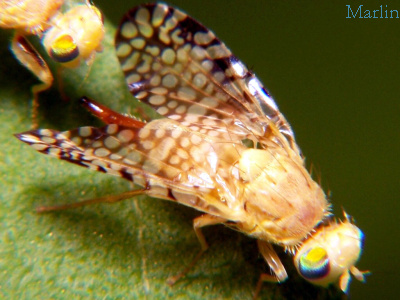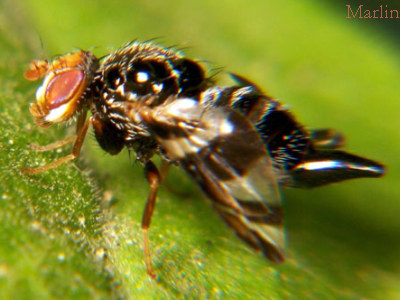| Family Tephritidae – Large Fruit Flies Most fruit flies lay their eggs in plant tissues, where the larvae find their first food upon emerging. Adults have a short lifespan. Sometimes call peacock flies after their showy colors and mating displays. |
|
|
There are nearly 5,000 described species of tephritid fruit fly in almost 500 genera. To distinguish them from the Drosophilidae, the Tephritidae are sometimes called "peacock flies."
Tephritid fruit flies are of major importance in agriculture. The genus Bactrocera is of worldwide notoriety for its destructive impact on agriculture. The olive fruit fly (B. oleae) feeds on only one plant: the wild or commercially cultivated olive. It has the capacity to ruin 100% of an olive crop by damaging the fruit. Most fruit flies lay their eggs in plant tissues, where the larvae find their first food upon emerging. The adults usually have a very short lifespan. Some live for less than a week. Some tephritids have mating rituals or territorial displays. |
|
I encountered these lovely flies along the shore of a small lake in northern Illinois. Dozens of them were engaged in a courtship ritual – the male was following the female around like a puppy dog – it was comical the way he stuck right on her tail. But every once in awhile, the female would turn around and the male would hold his wings toward her, in a sort of embrace, I imagined, and they would touch head-to-head. Kissing flies. What will they think of next?
|
 Euaresta aequalis |
 Procecidochares atra |
"Fruit fly" can refer to insects the family Tephritidae (large fruit flies) or Drosophilidae (small fruit flies or vinegar flies).
The species Drosophila melanogaster is an important model organism in modern biology; this species is also sometimes simply called Drosophila. |
|
Flies of North America – Order Diptera. Flies are prevalent in virtually all habitats, with over 16,000 species in North America. Flies can be distinguished from all other insects in that they only have one pair of normal wings. Most flies have compound eyes and mouthparts adapted for piercing, lapping or sucking fluids.
Syrphidae | Flies Index | Tachinidae | Bee Flies | Robber Flies |

